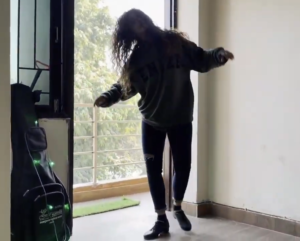National Tap Dance Day: Dancers put their best foot forward
Tying the laces of her specially-designed Tap shoes, 23-year-old Mrigya Tiwari gets ready for her daily dance rehearsals. She, unlike other dancers and performers, not only has to carry her shoes and costume, but also a giant wooden block that will enhance the quality of her performance on stage. Based in Haryana, Faridabad, Tiwari has to go an extra mile in order to perform on stage.
“I even use a block of wood for practice at home. We cannot perform Tap dance on any stage. It has to be designed specially, in accordance with the dancer’s demand. It has to be made of metal sheets, special tiles, or plywood in order to assist a Tap dancer. Otherwise, we cannot perform or any carpeted floor or ordinary concrete floors,” says Tiwari who has been learning the dance form for the past nine years in a dance academy in New Delhi.
The dance form Tiwari excels in, Tap dance is a type of dance characterised by using the sounds of metal taps affixed to the heel and toe of shoes striking the floor as a form of percussion, coupled with both characteristic and interpretative body movements.
In the early 19th century, it became extremely popular in the United States when slave owners took away traditional African percussion instruments, and slaves turned to percussive dancing to express themselves and retain their cultural identities.

Mrigya Tiwari says she was the only one in her class when she started learning Tap dance (Photo Credits: Mrigya Tiwari)
It was in the US that Pune-based Nikhil Gosavi learnt tap dancing. Thirty-year-old Gosavi has specialised in tap dancing and also has experience of almost a decade now. Gosavi went to learn dancing in an academy in New York in and that is where he fell in love with tap dancing. “I went to the US in 2013 to learn other dance forms like hip hop but it was over there that I discovered tap dancing and have been practicing as well as teaching it,” adds Gosavi.
“I was standing outside a dance academy in New York when I heard a very different kind of music and beats coming from inside. It made me curious and I went inside. There it was, a number of people doing Tap dance, and their shoes created that music. I was fascinated and decided to learn it and take it back to India. I did not know about it before that day,” remembers Gosavi.
Gosavi and Tiwari are among the very few Tap dancers in India. The artists say that while freestyle-dancing, breakdance, and hip hop have become a trend since the mid-2000, Tap dance is still relatively new in India.
“Not many people are trained in Tap dance yet. In many places, I have found out that there have been barely one or two dance students who exclusively learn this dance. I was also the only one in my dance class when I started learning this dance form. Though the number has increased a little, it is still nowhere near other dance forms,” says Delhi-based Tiwari.
Tiwari’s words echo true with Gosavi who goes on to say that he also had a similar experience in India. “Many times, I have been the only Tap dancer in a class or institution. Even while performing, I often have to share the stage with another dancer, mostly a classical dancer as audiences in India do not understand Tap dance,” he adds.
Gosavi further explains that the specialty of Tap dance is that it does not depend on any rhythm, beats, or music from outside. With the help of the metal or woodblock attached to the dancer’s shoes, the dancer can create their own music and dance to it. “It is a dance form that is more liberating than others. You do not have to ask someone to give beats. You can make you’re your own while you tap on the floor,” he adds.
He goes on to say that the sound of dancers’ feet tapping on the floor is an advantage as well as a disadvantage for many. He says that one has to be a little knowledgeable about musical notes and beats too in order to Tap dance properly. “It is a beautiful blending of music and movements together,” adds Gosavi.
Both the artists say that it often becomes a difficult job to catch audiences’ attention, getting more learners and even performing at places where people do not understand the dance form. “It happens a lot that we have to make special arrangements for a noise-free place and a wooden stage where we can perform. Usually, audiences cannot enjoy Tap dance if the auditorium is noisy and there is no point in performing if you cannot hear the tapping of the dancers’ feet,” explains Tiwari.
While she is still learning the dance form and performs on social media platforms, dancer Gosavi has started teaching to other students in person. He says that his dance academy is among the very few exclusively for Tap dance and though there are very few students currently, he hopes for the dance’s popularity to increase in coming years.
“Each new art form takes time. Just like other western dance forms became popular in India after they were adapted in a more Indian way, Tap dance too will become popular once people understand the musical essence it has and more performers adapt it in Indian ways. I feel that artists like me are doing their part by teaching and performing and it will soon be in demand and popular,” adds Gosavi.










